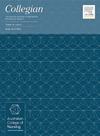Acute care nurses' perspectives on end-of-life dreams and visions: An interview study
IF 1.7
4区 医学
Q2 NURSING
引用次数: 0
Abstract
Aim
This study aimed to explore perspectives on end-of-life dreams and visions (ELDVs) of acute care nurses with experience in caring for dying patients.
Design
This study used a qualitative design, with face-to-face semistructured interviews and a reflexive thematic analysis. It was conducted from November 2023 to March 2024.
Setting/participants
Participants were medical and surgical nurses from a 200-bed acute care hospital in metropolitan Australia.
Findings
Eighteen nurses participated. Five main themes were generated:
- 1)Assessment and response evolve with repeated exposure, with subthemes:
- −Is it a delirium?,
- −To medicate or not medicate?, and
- −Moving from task-oriented to holistic care;
- −
- 2)Hesitant conversations;
- 3)A positive personal experience;
- 4)Education and training need to better equip nurses to provide holistic end-of-life care, and
- 5)The acute care setting predisposes to missed opportunities with subthemes
- –Speed of transition from active care to end-of-life care; and
- –Competing demands on nurse time.
- –
Conclusions
Development and feasibility of consensus-based guidelines to enable those providing end-of-life care, regardless of setting, to distinguish between an ELDV and a delirium, and practice guidelines to support patients and families, should be important inclusions to end-of-life education.
急症护理护士对临终梦和幻象的看法:一项访谈研究
目的探讨具有临终病人护理经验的急症护理护士的临终梦与愿景(ELDVs)。设计本研究采用定性设计,采用面对面半结构化访谈和反身性主题分析。该试验于2023年11月至2024年3月进行。背景/参与者:研究对象为澳大利亚大都市一家拥有200张床位的急症护理医院的内科和外科护士。结果18名护士参与。产生了五个主要主题:1)评估和反应随着反复暴露而演变,并伴有次主题:-这是谵妄吗?−用药还是不用药?2)犹豫的谈话;3)积极的个人体验;4)教育和培训需要更好地装备护士提供全面的临终关怀;5)急性护理环境容易错过机会,子主题:从主动护理到临终关怀的过渡速度;对护士时间的竞争需求。结论基于共识的指南的制定和可行性,使提供临终关怀的人,无论在何种环境下,能够区分ELDV和谵妄,以及支持患者和家属的实践指南,应该是临终教育的重要内容。
本文章由计算机程序翻译,如有差异,请以英文原文为准。
求助全文
约1分钟内获得全文
求助全文
来源期刊

Collegian
NURSING-
CiteScore
2.70
自引率
6.70%
发文量
127
审稿时长
72 days
期刊介绍:
Collegian: The Australian Journal of Nursing Practice, Scholarship and Research is the official journal of Australian College of Nursing (ACN).
The journal aims to reflect the broad interests of nurses and the nursing profession, and to challenge nurses on emerging areas of interest. It publishes research articles and scholarly discussion of nursing practice, policy and professional issues.
Papers published in the journal are peer reviewed by a double blind process using reviewers who meet high standards of academic and clinical expertise. Invited papers that contribute to nursing knowledge and debate are published at the discretion of the Editor.
The journal, online only from 2016, is available to members of ACN and also by separate subscription.
ACN believes that each and every nurse in Australia should have the opportunity to grow their career through quality education, and further our profession through representation. ACN is the voice of influence, providing the nursing expertise and experience required when government and key stakeholders are deciding the future of health.
 求助内容:
求助内容: 应助结果提醒方式:
应助结果提醒方式:


